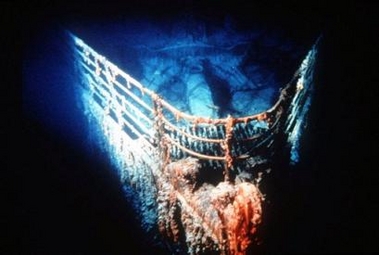|
Scientist: Titanic may have sank faster
(AP)
Updated: 2005-12-06 14:42
The discovery of two large pieces of the Titanic's hull on the ocean floor
indicates that the fabled luxury liner sank faster than previously thought,
researchers said Monday.

This is an undated
photo showing the bow of the Titanic at rest on the bottom of the North
Atlantic, about 400 miles southeast of Newfoundland. Undersea explorers
said Monday that the discovery of more wreckage from the Titanic suggests
that the luxury liner broke into three sections, not two, as commonly
thought, and thus sank faster than previously believed.
[AP/file] |
The hull pieces were a crucial part of the ship's structure and make up a
bottom section of the vessel that was missing when the wreck was first located
in 1985, the researchers said.
After the bottom section of the hull broke free, the bow and stern split,
said Roger Long, a naval architect who analyzed the find. The stern, which was
still buoyant and filled with survivors, likely plunged toward the ocean floor
about five minutes later.
"It would have been immediately terrifying," he said.
Previous researchers believed the ship broke in just two major pieces, the
bow and stern, which was how the sinking was depicted in the 1997 film version
of the catastrophe. David Brown, a Titanic historian, estimated before the
latest find that the stern took 20 minutes to slide into the water.
"It turns out the Titanic was more merciful. It was over more quickly," Brown
said.
The newly found hull sections, located about a third of a mile from the stern
of the wreck, were examined during an expedition in August sponsored by The
History Channel. On Monday, Titanic experts met at Woods Hole Oceanographic
Institution to discuss their analysis of the find for a documentary to be aired
on the cable channel on Feb. 26.
The sections, both about 40 feet by 90 feet, were once a single section and
were found in good condition, with red bottom paint still visible. The missing
sections had been believed to have fragmented into hundreds of small pieces.
"The breakup and sinking of the Titanic has never been accurately depicted,"
said Parks Stephenson, a Titanic historian who took part in Monday's conference.
The 46,000-ton ocean liner was billed as "practically unsinkable" by the
publicity magazines of the period. But it struck an iceberg on its maiden voyage
just before midnight on April 14, 1912, and sank the following day. About 1,500
people died.
Explorer Robert Ballard found the bulk of the wreck in 1985, at a depth of
13,000 feet and about 380 miles southeast of Newfoundland. Ballard was not
impressed with the expedition's find.
"They found a fragment, big deal," he said. "Am I surprised? No. When you go
down there, there's stuff all over the place. It hit an iceberg and it sank. Get
over it."
|